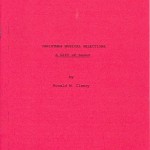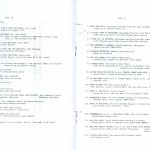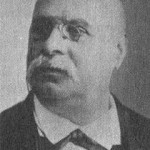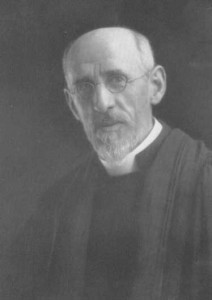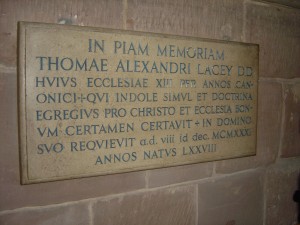Christmas Classics PERSON OF THE DAY: James Kimball Gannon
On this day in 1900, James Kimball Gannon was born in Brooklyn, New York. Better known as Kim Gannon, he was an American songwriter and lyricist for the perennial Christmas favorite I’ll Be Home for Christmas.
Gannon attended St. Lawrence University and as a senior wrote the school’s alma mater song The Scarlet and the Brown. A proud graduate of St. Lawrence in 1924, he had every intention of becoming a lawyer. The Great Depression delayed that career pursuit and in 1930 he was working as a salesman for a utility company. By 1934 he passed the New York state bar examination, but five years later the songwriting bug struck and soon after he composed his first commercial song, For Tonight.
The year 1942 found Gannon writing songs during the “swing era” and for films including the lyrics of the film title song Always in My Heart that earned him an Academy Award nomination for Best Song. He replicated that achievement twice more: 1) Too Much In Love for the film Song of the Open Road in 1944, and 2) Endlessly in 1945 for the film Earl Carroll Vanities. But in between he collaborated with Walter Kent in 1943 to produce I’ll Be Home for Christmas. Gannon also wrote songs for the films Powers Girl and If Winter Comes before Broadway beckoned in 1951 when he teamed up with Walter Kent again on the score for Seventeen.
Despite his success with film and Broadway, Gannon is best remembered for his popular and wistful Christmas lyric I’ll Be Home for Christmas. First recorded by Bing Crosby in 1943, it has since been recorded more than three hundred times and is an important part of American Christmas Classics.
The amiable Kim Gannon, who died in 1974, was always true to his alma mater. In his will he stipulated that after his wife Norma’s passing (she died in 2006), 30% of all royalty proceeds from his songs were to go to St. Lawrence University. The majority of those royalties, you can bet, come from his 39-word holiday classic I’ll Be Home for Christmas.
Christmas Classics PERSON OF THE DAY: Jack Rollins
On this day in 1906, Walter E. “Jack” Rollins was born in Scottdale, Pennsylvania. Better known as Jack Rollins, he is the songwriter credited with co-writing, supposedly with Steve Nelson, the Christmas holiday song Frosty the Snowman that is part of AMERICAN CHRISTMAS CLASSICS. That success came in 1950, just a year after Rollins, and supposedly Nelson again, collaborated on the popular Easter song Here Comes Peter Cottontail.
Rollins also co-wrote the song Smokey the Bear in 1952 after a wildfire swept across the Capitan Mountains in New Mexico, during the course of which firefighters noticed a lone bear cub climbing up a charred tree to escape being further burnt from the flames. The cub was rescued from his perch and given immediate veterinary care and ultimately was sent to the National Zoo in Washington. The story about the bear cub and its rescue lead to a national public service campaign to prevent forest fires with Smokey the Bear serving as mascot.
Rollins achieved a fair level of success with his children’s holiday songs, especially with the Gene Autry recording of Frosty the Snowman that sold over a million records. Rollins also co-wrote others songs for such country singers as George Jones and Eddie Arnold. Success, however, seemed to have come late in his career, one dotted with menial jobs. In 1940 he worked for a bakery. Eight years later he was a baggage clerk for Penn Station in New York. It was at that time when the 44 year old baggage clerk found the time to pen Frosty the Snowman and a number of other songs, and practically every night Rollins used to ask Frank (Zeb) Martello, the host of WOR mutual radio, to play them.
According to a letter from a Martello family member, Rollins and the radio host became friends and together they may have written five songs, including Rollins’ two most popular holiday songs Frosty the Snowman and Peter Cottontail. But Rollins asked Martello to take his name off the songs because some other well-known people, including “a guy by the name of Steve Nelson, for one, wanted his name on the songs before he would promote them.”
After the two songs became big hits, Martello was asked by his wife why he had removed his name from the two songs, insisting that he was always being the nice guy. Martello replied “Jack has a lot of talent, he deserves a break.” When asked if he ever regretted doing that, Martello said, “not really, but I guess mom could have used the money.”
Jack Rollins died in Cincinnati on January 1, 1973. The kind-hearted Zeb Martello on hearing the sad news was quoted to have said, “God Bless Jack, but I still have a lot to be thankful for.”
Christmas 1988 Starts Me on the Yellow Brick Road
In 1988 I thought it would be a neat idea to share the riches of my Christmas music collection. So for Christmas I gift-wrapped four audio cassettes of the finest recordings from my collection and gave them to family and friends. Each gift collection was accompanied by an 8-page type-written directory with a Chinese red cover titled “A Gift of Sound.” Besides having a decorative, though primitive look, the directory of song titles was intended to be easier on the eyes than my barely legible long-hand. Just imagine writing the same information on cassette index cards four times twelve, or forty-eight total! The thought was enough to give me writer’s cramps. My quaint IBM Selectric II typewriter, however, saved me the trouble and as a result the directory included not only selection titles, but also brief liner notes that sometimes indicated the origin of each carol, holiday song, or instrumental piece.
Some of my friends included those of the Jewish faith married to Christian partners. They admitted that although they usually felt left out at Christmas, they were indeed appreciative of my eclectic Christmas music gift. What made the collection special for most was the quality of the music. Quite unlike what they were accustomed to hearing during the holidays, it encompassed Gregorian chant, once the Christmas music of its day, and such classical pieces as "Anima Nostra,” Bach’s “Christmas Oratorio,” the German motet ""Hort zu lieben Leute," and the Spanish villancico, "Riu, Riu, Chiu” just to name a few. The collection was rounded out by lyrical English carols from the 16th and 17th centuries, and better known traditional fare, particularly carol hymns as "O Come, O Come Emmanuel” and “Adeste Fidelis,” or classic holiday songs as “White Christmas,” and “The Christmas Song.” In all, the four cassette collection totaled one hundred and twenty-four titles. Most came from England, France, Germany, and the United States. Entries from Austria, Czechoslovakia, Poland, Italy, and Sweden were also part of the mix. By the end of the 1988 Christmas season I was being encouraged by several friends to do something about my great interest in Christmas music, suggesting that I should pursue my interest and take advantage of my college degree. This I did. And in 1989 I was on my way.
SPECIAL PERSON OF THE DAY – Émile Waldteufel (December 9, 1837 – February 12, 1915)
The composer of Les Patineurs, Op. 183, Émile Waldteufel died in Paris and is buried at Cimetière du Père Lachaise there. The composer was born in Strasbourg, France to a Jewish Alsatian family of musicians. In 1882 he composed the best-known waltz of his career – Les Patineurs (a.k.a. "The Skaters’ Waltz" in English). Inspired by the Cercle des Patineurs, or "’Rink of Skaters’ at the Bois de Boulogne in Paris, the waltz has since been played in various venues, from concert halls to movies such as The Hollywood Revue of 1929 and Chariots of Fire, to music games like Gamecube’s “’Dance Dance Revolution Mario Mix” and Arc System Works’ “Princess on Ice.”
Waldteufel’s famous waltz evokes wonderful imagery: a poised skater gracefully gliding along the ice and swirling about a ring of other skaters as part of the wintry atmosphere. The delightful music includes the sound of bells that adds a nice touch to the outdoor scene. The noted conductor Arturo Toscanini led the NBC Symphony Orchestra on January 28, 1945, at Carnegie Hall, New York, in a fine RCA Victor recording of Les Patineurs
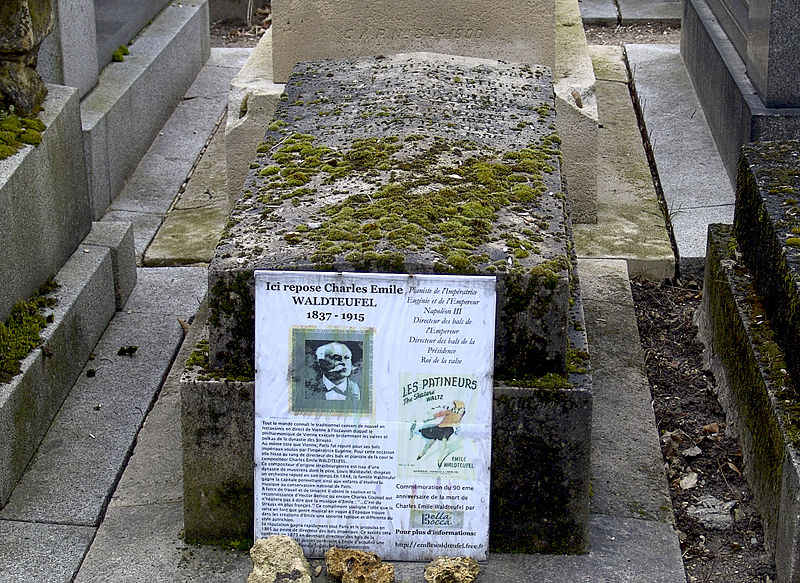
Grave of Émile Waldteufel
The Art of Collecting Christmas Music
Remember how record companies used to entice would-be customers to join their record clubs? You know, the mail-order offers of four or six or eight vinyl albums for only $.99 a pop as long as you purchased a minimum number of their selections-of-the-month or other albums of equal value? Columbia Record Club, which began the practice of marketing and distributing vinyl records in the late 1950s, led the way. RCA Record Club, a well as its Red Seal classical music label, and other record companies eventually followed suit.
Thirty years after hearing the sweet singing of carols by the Sisters of St. Joseph at my first Midnight Mass, I was in the process of assembling a small library of Christmas music. At the time I owned a medium-sized collection of pop and classical music, the latter for which I had acquired a taste during my teenage years, and my appreciation of Christmas music was definitely on the rise. To expand the library, I readily took advantage of Columbia and RCA marketing offers by enrolling in their record clubs. To maximize receiving benefits from each club, I would quickly fulfill my membership obligation by purchasing the minimum number of albums, and once I did, I would immediately cancel my membership. Since I was a member in good standing when I left, it wasn’t long before the same record clubs sent me new offers to join their clubs again. I almost always accepted, and the membership in-and-out cycle would repeat itself, thus enabling me to add significantly to my music library at a very reasonable cost.
But the record club that had the most impact on my assembling a substantial Christmas music library was The Musical Heritage Society of New Jersey. Like RCA’s Red Seal label, it too emphasized classical music as its reason d’être, and its annual Christmas catalog offerings, more generous and comprehensive in scope than the better known clubs, opened my eyes to the wonders of Renaissance, Baroque, and sacred music. What made these pre-CD era purchases possible were the amazing low prices, ranging from $2.50 and $5.45 per album or cassette.
My most memorable purchases, mostly from the Musical Heritage Society, included Michael Praetorius’ Christmas motets on period instruments, Italian Baroque Christmas concertos, colonial American hymns and carols, 15th-to-18th century English carols, especially those that were part of Benjamin Britton’s “A Ceremony of Carols,” and cantatas and oratorios by Back, Handel, and Mendelssohn. Adding to my delight were numerous albums of carols performed on a variety of instruments: organ, brass, harpsichord, panpipes, flute, carillon bells, harp, guitar, and music boxes. Other prized Christmas albums included performances by illustrious choirs and orchestras: the Choir of King’s College, Cambridge, the Vienna Boys Choir, and the Mormon Tabernacle Choir with the Philadelphia Orchestra, just to name a few.
By 1988 as a result of my systematic low-cost approach in taking advantage of various record club promotions, I had become the proud owner of a substantial Christmas music library. Later that year as I was feasting on my second helping of Thanksgiving turkey, a light bulb went on: Why not share my acquired riches with family and friends for Christmas!
SPECIAL PERSON OF THE DAY: Thomas Alexander Lacey (December 20, 1853 – December 6, 1931)
Rev. Thomas Alexander Lacey
Canon Lacey memorial at Worcester Cathedral
Buried in Garth cloister at Worcester Cathedral, England, are the remains of the Rev. Thomas Alexander Lacey, an Anglican priest, who died on December 6, 1931. His special contribution to the carol hymn repertoire was providing the most popular English translation O Come, O Come Emmanuel for “Veni, Emmanuel.” His translation of the Latin verses, which were based upon the great O Antiphons for the week prior to Christmas and are included in my first publication Best-Loved Christmas Carols (2000), first appeared in The English Hymnal (1906), a labor of love he had work on for many days and nights.
A great conversationalist and scholar noted of his expertise in Medieval Latin and Canon, Rev. Lacey lived the Christian ideal very much like John Mason Neale, another Anglican priest and the composer responsible for the adaptation of the Latin lyrics for Veni, Emmanuel. Both priests drew suspicion from their Anglican superiors because of their Catholic leanings, and in particular the Rev. Lacey was an apologist for the Anglo-Catholic position and devoted to the cause of ecclesiastical reunion. Both priests also worked among the less privileged or the afflicted. Lacey was a dedicated worker on behalf of girls in penitentiaries, and he once worked tirelessly during a typhus outbreak that occurred when he served at St. Benedict’s in Ardwick by persuading those infected and reluctant to leave their homes to allow him to carry them into ambulances.
Rev. Lacey eventually became assistant master of Denstone College and was made a Fellow of the College of St. Mary and St. John, Lichfield. That was followed by his appointment as vicar of St. Edmund, Northampton, then vicar of Madingley, Cambridge, and later as chaplain and then warden at the House of Mercy in Highgate, where there is ample testimony he had led a saintly life. In 1919 he was made Canon at Worcester in which capacity he served until his death.
Ron Clancy’s Love of Christmas Music Began at an Early Age
It all started during the 1950 Christmas season. That was quite an exhilarating time for a six-year old boy at St. John’s Orphan’s Asylum in Philadelphia. For starters, Thanksgiving dinner was made a grand affair by the good folks of the Knights of Columbus who annually volunteered their time to fete hundreds of starry-eyed boys. The delicious platters of turkey and all the trimmings just kept on coming until every one of us had his fill. But that wasn’t all! After dessert of pumpkin or apple pie a la mode, we were all treated to a Disney movie. It was truly a delightful day, especially poignant for those hundreds of boys who had experienced so much deprivation before being taken in by the orphanage nuns, a wonderful and odd assortment of women, who, without exception, honored the preciousness of life by taking in all the hundreds.
The next four weeks of that holiday season brought one festive party after another. Hosted by local companies and colleges, we were giddy from all the excitement leading up to Santa’s big day. And when Villanova University students came by to treat us to a day in downtown Philadelphia, well, that was just the best. That meant shopping for our own Christmas gift at one of the Quaker City’s premium department stores – John Wanamaker, Strawbridge & Clothier, Lit Brothers, or Gimbels. It was a thrill just strolling along, or milling about, with bustling crowds of shoppers, most of whom were neatly groomed and dressed, and pausing every so often to behold the magical winter wonderlands on display in the large storefront windows. Our merriment was of untold, almost mystical, proportion, and the popular holiday songs and carols that filled the air only added to our festive mood. That was my first fond memory of the joys of Christmas music.
After shopping for our presents, the Villanova students treated us to a grand lunch at Horn and Hardart’s, a glass-and-chrome cafeteria styled coin-operated automat and Philadelphia institution since 1902. We were grateful for the treasury of coins pressed into our hands and then the selection process to buy Horn and Hardart’s delicious offerings began in earnest. Ten cents for macaroni and cheese! Twenty-five cents for a chicken pot pie! Ten cents for a small carton of milk! Fifteen-cents for lemon meringue pie! And to top it off, we were treated to a matinee double-header – a Laurel & Hardy short and the comedy Fancy Pants with Bob Hope and Lucille Ball that left us in stitches. All and all, it was a fantastic day for us orphan boys.
Finally, on a snow-dusted Christmas Eve, we were roused from our comfy beds for what would be for our first Midnight Mass. To this day I have never forgotten the feeling of awe I had then on entering the chapel. The crèche on the side of the altar was magnificent and easily caught my eye. There were the statues of the Baby Jesus wrapped in swaddling clothes and surrounded by Joseph and Mary, shepherds, ox, ass and sheep, and overhead was an angel bearing the good tidings. “Gloria in excelsis Deo. Et in terra pax hominibus bonae voluntatis.” (Glory to God in the highest. And one earth peace to men of good will.)
The ceremonial burning of frankincense only added to the drowsy and sweet intoxication caused by the lush fragrance of Christmas firs tethered to the pillars throughout the intimate chapel. But what mostly enhanced my wonderment, which made the occasion truly memorable, was the singing of Christmas carols. Sung beautifully by a small choir of nuns, the enchanting notes of the mystic “O Come, O Come, Emmanuel,” the reverential “Silent Night,” the Latin hymn “Adeste Fideles,” and other sacred carols seemed to spiral heavenward as though on the wings of angels. After that Midnight Mass and holiday season, I was hooked.
SPECIAL PERSON OF THE DAY: William E. Studwell (March 18, 1936 – August 2, 2010)
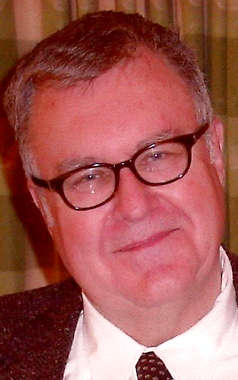
For the modern-day fraternity dedicated to preserving the history and legacy of Christmas carols, the recent death of William E. Studwell caused a great deal of sadness. A truly remarkable, as well as a great friend and trusted colleague, Studwell was a leading international authority on Christmas carols. His significant publication Christmas Carols: A Reference Guide (1985) is one of the best references on the subject and includes information on 789 carols. Publishing Glad Tidings: Essays on Christmas Music (1998), an excellent resource he co-authored, provides interesting insights about the personalities of major carol composers and carol book compilers. Other fine titles are his The Christmas Carol Reader (1995) and An Easy Guide to Christmas Carols: Their Past, Present and Future (2006), the latter which contains his list of the top 25 Christmas carols.
Despite suffering a neurological disorder that plagued him for a good portion of his life, that did not deter Prof. Studwell, as I like to address him, writing numerous articles about carols and other subjects, or editing nine of my Christmas music manuscripts in the mid-1990s, four of which have since been published. One of his favorite activities, though, was bequeathing to the public his annual “Carol of the Year,” a practice he began in 1986.
This year will be the 25th anniversary of his special holiday h’ors d’oeuvre, but sadly it will be his last. Prof. Studwell, though, must have sensed his end was near, having fallen ill with lymphoma earlier in the year. The day before he died he corresponded with his daughter Laura with specific details about his final installment of “Carol of the Year,” which will soon be published.
Prof. Studwell was an affable sort who was also much respected among academic librarians. The seventh child of a lower-middle class working family from Stamford, Connecticut, he once worked for the Library of Congress in the technical division of the Soviet and Russian collection, and there he developed an interest in Library Science. Three years after earning a Master of Library Science degree from Catholic University in 1967, he became head cataloger at the University of Libraries, Northern Illinois University where he distinguished himself for thirty-one years as the best library cataloger in the United States. At the same time, too, he was bringing honor to the annals of Christmas music by writing prodigiously on the topic. To those of us who are keenly aware of his work, he has rightfully carved out a special place for himself in the pantheon of Christmas carol contributors.
Christmas Music Expert to Tell Unique Story in Blogs
Welcome to Christmas Classics Ltd., publisher and producer of exquisitely illustrated Christmas music collections, and Ron Clancy’s daily blog.
Only recently Ron was encouraged by several well-intentioned media folks to talk about the untold story of how he came to create exquisite Christmas music collections. But this is like asking a gourmand to dine on a swamp toad. His initial reluctance, however, soon melted away in recognition of the fact that 2010 is the 10th anniversary of the publication of his first title Best-Loved Christmas Carols.
That joyous event, seemingly a long time, was the unfolding of a mystical dream. The question was what medium Ron should use to tell his story. And then it came to him: write a blog, something which he had never done before. And blog it will be!
The daily blog will describe the twists and turns that lead to his becoming a publisher, a career that came by default since no publishing company or other enterprise expressed any interest in his Christmas music concepts. Deflated and sitting alone in his office in December 1999, he despaired about having nothing to show for ten years of exhaustive research about the origins of Christmas music. The more he sat, the more he realized that he had to do something, and that if I didn’t his dream would go to seed and years of obsessive efforts would wither in vain. Ron decided then and there to go it alone, and within days the paperwork to begin Christmas Classics Ltd. was officially filed with the state of New Jersey.
The adventure to self-publish will be told in episodic detail about what the corporate titans of direct marketing, Reader’s Digest and Time-Life Music, considered an “overly ambitious” or “tilting at the wind” effort to create ne plus ultra Christmas music collections. The daily blog will also feature a SPECIAL PERSON OF THE DAY – composer, lyricist, translator, clergyman, or other distinguished person who has contributed to the Christmas music repertoire.
Ron’s creative contributions to the repertoire are four highly illustrated compilations of favorite traditional carols, holiday songs, and classical pieces, each unique in its own way, but in sum providing an informative, and indeed novel, perspective on the history of Christmas music from the early years of Christianity to the 20th century.
What always energized Ron to go where others dared not tread was one simple objective: showcase in magnificent sight and sound the entire spectrum of Christmas music. Although some of that music still receives scant notice in our overly secularized commercial world, here is where he was determined to make a difference.
In the end his Christmas music collections may open the window, even if it is just a crack, to the beauty of liturgical and classical works that honor the seminal event of the Western World – the Nativity of our Lord and Savior Jesus Christ. Thus, timeless Gregorian chant, sacred motets, instrumental pieces, such as Baroque Christmas concerti, all part of Sacred Christmas Music, share the stage with popular holiday fare for ballet, opera, and our much-loved traditional carols and songs.
The years of rearch and then publication of his findings, including two editions licensed by Sterling Publishing, have earned Ron the humble distinction as one of the leading experts on the history of Christmas music.
That was never his intention. What he wanted was simply to share his love for Christmas music by presenting it in a beautiful format that would ultimately astonish and amaze and become a cherished family heirloom. In so doing, Ron had hoped to enrich the legacy of Christmas music by raising it above the mundane.
Whether he has succeeded is not for us to say, but you may wish to learn about this episodic adventure by following his daily blog. Along the way you will also learn about the unique contributions of the Special Person of the Day.
All the best and Merry Christmas!
Christmas Classics Ltd.
www.christmasclassics.com


